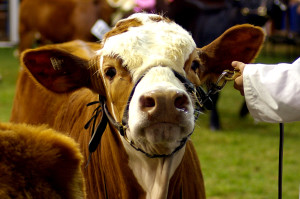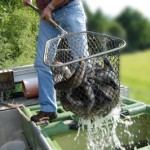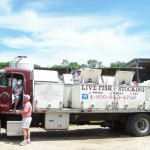Visit with a seasoned athlete about their daily routine, and there’s a high likelihood they will credit the use of nutritional supplements to boost their performance before a big competition.
 Similarly, on the show cattle circuit, individuals in the winner’s circle can often be found using show supplements for their steer or heifer.
Similarly, on the show cattle circuit, individuals in the winner’s circle can often be found using show supplements for their steer or heifer.
“Show supplements are designed to help spike the nutrition being offered to an animal to enhance the expression of genetic traits in a 45- to 90-day time period,” explains Dr. Kevin Burgoon, technical nutritionist with Purina Animal Nutrition. That said, he emphasizes, “Show supplements are not a magic potion, they are part of a comprehensive nutrition program.”
Burgoon explains that nutritional supplements don’t replace a balanced feed ration. Supplements are simply added for a period of time to help boost specific nutrients to achieve a desired result. Burgoon says show supplements are most often fed to cattle for three reasons: 1) to help achieve appropriate fat and conditioning for finishing, 2) to help enhance the animal’s muscle expression, and 3) to help promote a fuller appearance.
“You must still meet the animal’s daily nutrient requirements says Burgoon. “Then, adding show supplements with higher amounts of a specific nutrient, like energy or protein, can help get an animal looking their best for show day.”
Energy is key
When selecting a nutritional supplement for cattle it is important to look at the fat content, which provides the animal energy (calories). Burgoon says, “Energy is responsible for growth, muscle and skeletal development; every metabolic process has a caloric cost.”
Specifically, Burgoon suggests including a high fat energy supplement in a show animal’s diet when more energy is needed for growth and or fat deposition. “A high fat supplement can help the animal utilize the feed better and promotes fat deposition to help achieve the desired finishing condition,” he explains. “A high protein, low fat supplement can dilute the energy content of the diet to a point where growth and fat deposition suffers.”
Energy supplements can also be beneficial to speed up growth and finishing in scenarios where an animal would traditionally require longer days on feed, such as cattle that have been sick or off-feed or breeds that take longer to mature. For those animals who need an extra boost, Burgoon says energy supplements can start to be fed when cattle are 400 to 500 pounds.
In addition, feeding enough fiber in the diet is critical. Burgoon suggests free choice moderate quality grass hay, and emphasizes that “keeping the rumen right with sufficient roughage in the diet is critical.”
Allow enough time
Burgoon emphasizes that inclusion of nutritional supplements in a feed ration requires time.
“When someone says a supplement didn’t work for their show animal, it’s usually because they didn’t feed the supplement for a long enough period of time for it to work. Timing is the biggest mistake I see people make when feeding nutritional supplements,” says Burgoon.
According to Burgoon, ideally nutritional supplements should be fed 45 to 90 days prior to show day. Even products marketed as a “show day” supplement should be fed longer than a single day he adds. “Supplements continue to work the longer they are fed,” Burgoon adds.
Part of the bigger picture
As part of your comprehensive nutrition program, Burgoon suggests getting show calves – especially market steers – to their ideal finishing weight about 35 to 40 days prior to show day, and then transitioning to a lower energy, high fiber feed and, if needed, feeding a supplement that will help maintain condition and muscle shape until it’s show time.
He adds once animals have reached their ideal finish weight you must still continue to meet their daily nutrient requirements, but you want to do that with as little feed as possible. He advises transitioning to a “slowing diet” – feeding lower energy and increasing the fiber to at least 14%, with free choice grass hay to keep the calf full, while also keeping their condition and muscle expression “fresh.”
During the final 30 to 45 days before a market show, Burgoon also emphasizes the importance of feeding supplements and feeds that do not require a withdrawal period.
Monitor performance
A final tip is to monitor how animals are eating and responding to their feed and supplements. Burgoon notes that adjustments to their diet may need to be made throughout the show season.
Honor® Show Chow® Ambassador Bobby May has similar advice. May emphasizes that every animal and every feeding scenario is different, saying, “There’s never a one size fits all feeding recommendation.”
To monitor performance of the show animals he works with, May says he weighs his show cattle every week to evaluate gain.
May also advises feeding cattle separately. He explains, “If you feed 20 pounds of feed to two steers, there is no guarantee they will each eat 10 pounds, because some cattle are slow eaters and others are aggressive. I suggest feeding cattle separately, but putting the bunks side-by-side and separated by a fenceline so the cattle feel like they are eating with a buddy.”
For more information on show nutrition join the online community of show enthusiasts at www.facebook.com/HonorShowChow or www.twitter.com/HonorShowChow.
Article Attributed to Purina Animal Nutrition


